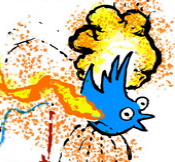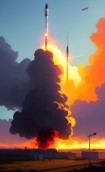|
https://www.politico.com/news/2023/03/07/u-s-military-air-to-air-missiles-ukrainian-migs-00085877 U.S. is looking at mounting AIM-120 air-to-air missiles on MiG's. Not a lot of meat on the bone of this story yet, mostly just confirming that it's being actively looked at. Would be a bit of a hack to get the aircraft and missile to interface since the aircraft's radar has to provide initial guidance. We already provided AGM-88 HARMs for ground attack, but there isn't a lot of hard info about how integrated they are with aircraft systems since they have the capability to be essentially dumb fired. Hard to know how much air-to-air combat will ensue in any Ukrainian offensive, but this does imply that the U.S. wants them to have the capability to provide air support.
|
|
|
|

|
| # ? May 23, 2024 23:45 |
|
Round-Up of News of the Day Office of the President of Ukraine quote:https://www.president.gov.ua/en/news/ukrayina-zavzhdi-pamyatatime-svoyih-geroyiv-nasha-pamyat-pro-81485 Kyiv Independent quote:https://kyivindependent.com/news-feed/hero-of-ukraine-dmytro-kotsiubailo-killed-in-action quote:https://en.wikipedia.org/wiki/Dmytro_Kotsiubailo quote:https://en.wikipedia.org/wiki/Right_Sector
|
|
|
|
Vietnom nom nom posted:https://www.politico.com/news/2023/03/07/u-s-military-air-to-air-missiles-ukrainian-migs-00085877 I wonder what the air war is like now. There seems to be so little coverage or awareness, just tidbits like the video and article of UAF Mi-8s fitted with rocket launchers, and a recent tweet about Bakhmut where it is indicated that Ukrainian soldiers are "regularly strafed" by Russian attack helicopters. It seems like aircraft have depleted on both sides, whereas helicopters are still in use probably because of their ability to fly NOE so well. That said, it suggests that Ukranian MANPADs may be in shorter supply...although I have not seen indications that Ukraine has been asking for these.
|
|
|
|
A history of the strategic value of Bakhmut 24 January 2023 - "US and Western officials" quote:https://edition.cnn.com/2023/01/24/politics/ukraine-shift-tactics-bakhmut/index.html 7 February 2023 - Yehor Cherniev, a Ukrainian lawmaker and head of the Ukrainian delegation to the NATO parliamentary assembly quote:https://time.com/6253515/bakhmut-battle-ukraine-russia/ 4 March 2023 - U.S. Defense Secretary Lloyd Austin quote:https://www.voanews.com/a/us-defense-chief-says-ukraine-s-bakhmut-has-more-symbolic-than-strategic-value/6991380.html 6 March 2023 - "Analysts" quote:https://www.pbs.org/newshour/world/ukraine-vows-to-hold-bakhmut-as-russia-continues-fight-to-capture-the-city 7 March 2023 - "Analysts" quote:https://www.washingtonpost.com/world/2023/03/03/bakhmut-battle-ukraine-russia/ 7 March 2023 - "Military experts and close watchers of the Ukrainian battlefields" quote:https://www.rferl.org/a/ukraine-war-bakhmut-significance/32307329.html 7 March 2023 - "Analysts" quote:https://www.bbc.com/news/world-europe-64864496 7 March 2023 - Institute for the Study of War quote:https://www.euronews.com/2023/03/07/ukraine-to-continue-fight-for-bakhmut-as-russian-troops-struggle-to-make-gains 7 March 2023 - President of Ukraine Volodymyr Zelensky quote:https://edition.cnn.com/2023/03/07/europe/ukraine-volodymyr-zelensky-cnn-interview-bakhmut-intl/index.html (USER WAS PUT ON PROBATION FOR THIS POST)
|
|
|
|
I don't know if anyone listens to NPR's State of Ukraine, but I thought this latest episode was interesting (and also depressing outlook wise)NPR State of Ukraine posted:Ukrainian soldiers speak bluntly about the challenges they face
|
|
|
|
Irony Be My Shield posted:Hersh's piece leans very heavily into pro-Russian narratives, including some that are obviously and demonstrably false (eg the idea that the only reason Germany currently isn't importing Russian gas is due to the sabotage - Russia cut the flow of gas off well before and has not restored it since even though there is a surviving pipeline). It's catnip for people who already support Russia but it's unlikely to convince many who weren't already on that team. I'd just like to point out that the surviving pipe is part of NS2, which was dead before the invasion. Russia graciously offered to export gas if only Germany let NS2 open, but at the point of the explosions full divestment from Russia had already been decided and was under way. The attacks did gently caress all beyond demonstrating that infrastructure was vulnerable.
|
|
|
|
Huggybear posted:I wonder what the air war is like now. There seems to be so little coverage or awareness, just tidbits like the video and article of UAF Mi-8s fitted with rocket launchers, and a recent tweet about Bakhmut where it is indicated that Ukrainian soldiers are "regularly strafed" by Russian attack helicopters. It seems like aircraft have depleted on both sides, whereas helicopters are still in use probably because of their ability to fly NOE so well. That said, it suggests that Ukranian MANPADs may be in shorter supply...although I have not seen indications that Ukraine has been asking for these. It's not that. The Russians (and Ukrainians to a lesser extent) are using helicopters by flying into the air, pulling the nose up and firing a bunch of dumb rockets over parabolic arcs into enemy positions from beyond MANPADS range. It's not the most efficient way, but it is the safest.
|
|
|
|
Tevery Best posted:It's not that. The Russians (and Ukrainians to a lesser extent) are using helicopters by flying into the air, pulling the nose up and firing a bunch of dumb rockets over parabolic arcs into enemy positions from beyond MANPADS range. It's not the most efficient way, but it is the safest. So that is what, over 15-20km? That's basically an airborne Katyusha at this point, incredible. On Bakhmut, there's an article (in Polish, paywalled so I reposted it here)with a bit more analysis of the meeting of Zelensky and the 2 generals, Załużny and Syryjski - out of these 2, Syryjski is the more interesting one: Currently he's the leader of the ground forces and, importantly, he has graduated from the Moscow Higher Military Command School - meaning he knows Russian style of warfare and the tactics used. It's more of "let them fight and bleed themselves dry" but the reasoning is that Ukraine can hold on so long and inflict serious damage because of the military structure of Russia. There are 4 command centers fighting in this war, and they are all fighting on their own. The Eastern, Western, Central and Southern command are all separated and with their own leadership. The central one is the one fighting in Bakhmut, while the other ones are doing their own thing. And they won't help eachother out, since they all have their own piece of the land to worry about. So by keeping one part of the russian forces occupied, they can actually inflict significant damage - it's not that Russians will just "throw more men", because they don't cooperate like that. Unfortunately, the central one is the one with Wagner so that's what we're seeing. And Bakhmut will fall eventually. But I don't think that Ukraininan leaders are huffing their own farts and counting on the Stalingrad 2.0 scenario, it's a cold calculation that fighting there is the best option. Even for the upoming counterattack after leaving the city.
|
|
|
|
They aren't shooting beyond visual range, just pulling up the nose a bit. 4km or so, perhaps more with a more aggressive ballistic arc. The firing computer has a mode for this iirc, so they have CCIP available.
|
|
|
|
Antigravitas posted:They aren't shooting beyond visual range, just pulling up the nose a bit. 4km or so, perhaps more with a more aggressive ballistic arc. The firing computer has a mode for this iirc, so they have CCIP available. They're pulling the nose up pretty substantially in many of the recorded incidents and would have no line of sight to the target. The rockets in question are designed for direct fire at high velocity and become unstable/inaccurate when fired in a ballistic arc over longer distances where they end up very low velocity (same reason the FFARs off the back of a technical are ineffective). The CCIP bit is also very questionable - I haven't seen a reliable source on that claim. It's an incredibly inaccurate way to fire rockets, which is why it's not really impacting anything. But the helicopters don't need to climb off the deck or approach close enough to hostile lines to get shot down. Which is why you only started seeing this after a large chunk of the Russian attack helicopter fleet was already burning in Ukrainian fields after attempts to use them the way they're designed to be used. Warbadger fucked around with this message at 13:35 on Mar 8, 2023 |
|
|
|
I was under the impression that they were shooting basically from the edge of the envelope of the rockets, not like some artillery system. If they are doing beyond visual range, that's… kind of a waste of ammunition. They are inaccurate as gently caress at that range, that much is certain. I can't find where I read it, but I am reasonably certain that shooting with a ballistic trajectory was a manoeuvre supported by the firing computer. Of course I may be conflating the two. I haven't been watching too many videos of helicopters firing their rockets, but the ones I've seen weren't pitched up too high.
|
|
|
|
Antigravitas posted:I was under the impression that they were shooting basically from the edge of the envelope of the rockets, not like some artillery system. If they are doing beyond visual range, that's… kind of a waste of ammunition. I know it is supported like that on some bombers and dumb munitions, haven't seen anything on helicopters and rockets.
|
|
|
|
If they are shooting beyond the horizon I retract everything I've said on this, because… the gently caress?
|
|
|
|
Antigravitas posted:I was under the impression that they were shooting basically from the edge of the envelope of the rockets, not like some artillery system. If they are doing beyond visual range, that's… kind of a waste of ammunition. There is FLIR footage of such rocket attacks (I haven't linked it because while the video itself doesn't show anyone at all being hurt, I can't find a YouTube link anymore, and the site where I can find it is pretty loving sketch with NMS poo poo advertised). In some cases, the troops on the receiving end have stated that while there's rather little chance of being killed by such rocket attacks, it keeps people up, causes reporting, etc, so is just a way to generally harass and exhaust troops at night. In the HUD footage, for a lot of these, you can see that they're not getting the aimpoint/predicted impact point. They're doing the vague artillery math of going to a point, pulling back to X degrees, and firing, which will at least get you plus or minus a km or so of target, maybe better. In contrast, there's early war footage of attack helos actually using their rockets and guns pippers and putting accurate direct fire onto enemy forces.
|
|
|
|
I guess I'm misremembering then. And I am very disturbed.
|
|
|
|
mlmp08 posted:In some cases, the troops on the receiving end have stated that while there's rather little chance of being killed by such rocket attacks, it keeps people up, causes reporting, etc, so is just a way to generally harass and exhaust troops at night. Weird to see an actual army employ the afghan insurgent method of rocket attacks.
|
|
|
|
On the cluster bomb topic: https://www.reuters.com/world/europe/ukraine-seeks-us-cluster-bombs-adapt-drone-use-lawmakers-2023-03-06/quote:Ukraine has broadened a request for controversial cluster bombs from the United States to include a weapon that it wants to cannibalize to drop the anti-armor bomblets it contains on Russian forces from drones, according to two U.S. lawmakers. That's quite a twist.
|
|
|
|
Are those more powerful than grenades in some way? Or are they beginning to run out of grenades...?
|
|
|
|
OddObserver posted:Are those more powerful than grenades in some way? Or are they beginning to run out of grenades...? quote:The Ukrainian military believes these submunitions "have better armor-piercing capability" than the weapons it has been dropping from drones, said Smith, the top Democrat on the Armed Services Committee.
|
|
|
|
https://en.wikipedia.org/wiki/CBU-100_Cluster_Bomb It's an AT cluster bomb and the bomblets are designed for AT. It's an interesting twist because for obvious reasons, everyone is a bit iffy about delivering cluster bombs.
|
|
|
|
 Looks like a miniature HEAT round
|
|
|
|
Charlotte Hornets posted:
Pretty sure anything AT is going to look similar-ish. Until there’s a breakthrough, that is 
|
|
|
|
It obviously has better AP capabilities with that shaped charge than a mortar round or frag grenade. I wonder if they'll be able to ship just the bomblets and which poor grunt is going to have to open up all of those cluster bombs and take all of the bomblets out.
|
|
|
|
These things are banned by most countries because they tend to not detonate and kill random civilians after the threat is gone, yes including "anti-armour" rockeyes. I'd really rather not saturate any occupied ukrainian cities with them or proliferate them tbqh
|
|
|
|
Charlotte Hornets posted:
The forbidden lawn dart (or NLAW dart, if you will)
|
|
|
|
Edgar Allen Ho posted:These things are banned by most countries because they tend to not detonate and kill random civilians after the threat is gone, yes including "anti-armour" rockeyes. I'd really rather not saturate any occupied ukrainian cities with them or proliferate them tbqh this is true of all the other drone dropped munitions, many of which are also repurposed cluster bomblets
|
|
|
|
Edgar Allen Ho posted:These things are banned by most countries because they tend to not detonate and kill random civilians after the threat is gone, yes including "anti-armour" rockeyes. I'd really rather not saturate any occupied ukrainian cities with them or proliferate them tbqh Anyway, article mentions that White House is not inclined to send them to Ukraine.
|
|
|
|
Edgar Allen Ho posted:These things are banned by most countries because they tend to not detonate and kill random civilians after the threat is gone, yes including "anti-armour" rockeyes. I'd really rather not saturate any occupied ukrainian cities with them or proliferate them tbqh The main issue is that these are typically dropped randomly from a bomb over a large area, instead of directly on top of a target from a drone.
|
|
|
|
Edgar Allen Ho posted:These things are banned by most countries because they tend to not detonate and kill random civilians after the threat is gone, yes including "anti-armour" rockeyes. I'd really rather not saturate any occupied ukrainian cities with them or proliferate them tbqh Trench lines are so full of artillery shells and rockets fired by the tens of thousands that they're going to take decades to clean up. Drones dropping individual explosives one at a time hardly make any difference, and may actually be less damaging because they fall from a short distance and won't penetrate into the ground.
|
|
|
|
The drone bombs that hit their target and work are actually worse, you can get lots of scattered UXO when a T-72 or BMP blows up.
|
|
|
|
Icon Of Sin posted:Pretty sure anything AT is going to look similar-ish. Until there’s a breakthrough, that is This joke? it goes deep saratoga posted:Trench lines are so full of artillery shells and rockets fired by the tens of thousands that they're going to take decades to clean up. Drones dropping individual explosives one at a time hardly make any difference, and may actually be less damaging because they fall from a short distance and won't penetrate into the ground. I am starting to think back to the history of areas in modern day france which are still unoccupied due to catastrophic war damage/refuse and thinking about how much of ukraine will be similarly uninhabitable for lifetimes
|
|
|
Edgar Allen Ho posted:These things are banned by most countries because they tend to not detonate and kill random civilians after the threat is gone, yes including "anti-armour" rockeyes. I'd really rather not saturate any occupied ukrainian cities with them or proliferate them tbqh I think UXOs is a solid concern, but I'm not sure if this would be a meaningful threat profile change given the intensity and scrappiness of warfare going on. Specifically, I say that since the ask seems to be to get the cluster submunitions, to be dropped 1 piece at a time via drones. Rather than to get the cluster bombs themselves and then spray wheat fields with piles of grenades.
|
|
|
|
|
Antigravitas posted:https://en.wikipedia.org/wiki/CBU-100_Cluster_Bomb Then in a sane world the United States can do one of a couple things 1) neuter them so they can't be used as a deployable munition in the form of a clusterbomb 2) dismantle them themselves and handover The individual bomblets 3) give Ukraine something similar that isn't part of a cluster munition that might actually work out better because it is purpose-built for this sort of thing (I don't think the United States has anything that is built to be dropped from a DJI though)
|
|
|
|
This is a detailed three-part series of articles on how the Nord Stream sabotage went down from the Danish perspective. The focus is on how ill-prepared Denmark's crisis management was. You'll have to translate it, but it's an interesting read. https://www.zetland.dk/historie/sO0VrdNb-mo46mbZz-281a8 https://www.zetland.dk/historie/sO9aZd56-mo46mbZz-4933a https://www.zetland.dk/historie/s8D3lK6d-mo46mbZz-f5c1c quote:On Monday morning – around eight hours after the explosion – a team of seismologists met in inner Copenhagen. It was a regular routine that they met every morning and looked at the graphs from the past 24 hours to see if anything startling had happened in the Danish underground. If the seismologists from the National Geological Surveys for Denmark and Greenland - usually known as GEUS - discovered data from the graph on Bornholm, they would have crucial knowledge about the explosion and the location of the leak, which the Norwegian Defense Forces currently lacked. But the researchers only looked at data up to 2 a.m. Monday. As mentioned, the explosion happened at 2.03 Danish time. In other words: If the explosion had happened just four minutes earlier, it would have appeared in the material the seismologists had in front of them. But the seismologists were evidently right this morning “ unfortunate”, as one employee later remarked. GEUS found nothing interesting in their graphs, and there was therefore naturally nothing to alert other authorities about. quote:The three-masted Norwegian school ship Christian Radich with large white sails was on his way from Oslo to Gotland and was heading directly for the new leaks. The mate now got a call over the radio. A ship in the distance reported that something out in the dark sea was standing upright. It was quite mysterious. The sea was bubbling or something reminiscent of it. Just over 20 minutes had passed since the latest explosions, and neither the Ministry of Defence, the Prime Minister's Office nor the training ship out on the Baltic Sea knew yet that another attack had taken place. Fridtjof Jungeling was sitting in his cabin this Monday evening, and the experienced 50-year-old captain actually had time off after setting the ship on the right course with the 28 maladjusted youngsters that the school system had abandoned. Now they were going on a four-week trip to teach the young men how to become real sailors. He was looking forward to the sailing trip. quote:Anders Puck Nielsen is a military analyst at the Center for Maritime Operations at the Norwegian Defense Academy. He says that the Nord Stream explosions have exposed a truth that many in the Armed Forces have thought about for a long time: that we are almost blind when it comes to the Baltic Sea. quote:Let's leave the crime scene and instead move to what we might call the forensics section of the article. Because how on earth do you manage to blow up a tonne-heavy gas pipe made of concrete and steel? Peter Hald, a chemist specializing in explosives at Aarhus University and a former officer at the Norwegian Army's Engineer Regiment, can enlighten us on that. quote:While it seems contradictory that Russia would blow up its own gas pipeline, what about ... the country that Russia is trying to invade? Ukraine is far from the Baltic Sea, but one of the theories is that it was Ukrainian special forces who blew up the pipes. So that's theory number two: the Ukrainians did it.
|
|
|
|
Foreign Affairs has an interesting article about Russia's half measures despite talking tough. quote:Russia’s Halfway to Hell Strategy
|
|
|
|
According to the Times, western intelligence agencies have known for months that the pipeline attack was a private Ukrainian venture with no affiliations with Zelenskyy's administration. https://www.thetimes.co.uk/article/west-nato-nord-stream-attacks-protect-ukraine-qsrqxvssw
|
|
|
|
Also, I'll need to ask people to stop posting 2814 word walls of text written by someone else to this thread. I'm still working on finalizing some rules changes for the thread, but posts likeMoon Slayer posted:Foreign Affairs has an interesting article about Russia's half measures despite talking tough.
|
|
|
|
|
cinci zoo sniper posted:Also, I'll need to ask people to stop posting 2814 word walls of text written by someone else to this thread. I'm still working on finalizing some rules changes for the thread, but posts like It's because most interesting articles are behind paywalls, and if just a link and description are posted inevitably there are half a dozen posts requesting someone to quote and post the whole thing. I've just gotten in the habit of posting full articles to avoid the thread clutter. People can scroll past them if they're not interested.
|
|
|
|
Deteriorata posted:It's because most interesting articles are behind paywalls, and if just a link and description are posted inevitably there are half a dozen posts requesting someone to quote and post the whole thing. Same, I do it specifically because I usually can't be bothered to click through when others link articles. Obviously if it becomes a thread rule I'll stop.
|
|
|
|

|
| # ? May 23, 2024 23:45 |
|
Kavros posted:
The no-go zones in France are more due to the risk of disturbing poison gas munitions than the threat from explosives.
|
|
|





























